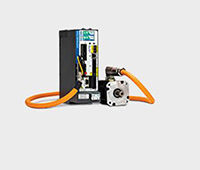The high switching speeds of modern power electronics call for sensors able to keep up with the megahertz-level frequencies involved. Anisotropic magneto-resistive technology fits the bill.
Khagendra Thapa, Aceinna Inc.
In automation, use of precision current-sensing is of growing importance. Material handling equipment often uses position and velocity feedback that frequently involves measurement of motor or other actuator current. Similarly, advanced current sensing is also necessary to implement numerous energy efficiency measures, as well as for monitoring equipment safety and reliability. In automotive systems, current-sensing helps manage the motor and powertrain.
The migration from passive systems to those using intelligent feedback and control has yielded impressive results. But in discussions of feedback, people often conflate accuracy and precision. They are similar but different things. A good analogy is to think of shooting a bow and arrow, or even just throwing darts. Precision is how closely all of your shots are grouped together. Accuracy is how close that shot group is to the target. You can have an industrial machine capable of drilling a half-millimeter hole in the “o” in a coin, but unless you have the accuracy to put that force in the right place, its precision is wasted.
Overall, power system and motor-drive open-loop current-sense accuracy has been an already-impressive ~5% over full temperature range in recent years. Recent Industry 4.0 approaches have moved the goal post towards below 3% at temperatures as high as 105°C. In the area of advanced solar inverters, systems are beginning to realize 2% max accuracy over temperature. High-performance CNC motors will typically look for greater than 1% accuracy over temperature.
Similarly, applications needing extremely wide dynamic range, with good accuracy and
precision, will need better than 1% accuracy over temperature. For better control and protection, typical power factor control (PFC) and mainstream power supplies also want better than 1% at room temperature and better than 3% over their operating range. Some high-performance power systems optimize accuracy, thermal management, and overall system performance demand for 1% over temperature.
Thermal issues
One axiom in embedded engineering is that power management is thermal management. Power efficiency and thermal performance go hand in hand. A reduction in temperature makes electronics work better and more reliably. Conversely, electronics that operates more efficiently generates less waste heat and has fewer thermal-management issues. Optimizing both power and thermal management will significantly improve productivity and cost.
Inverter, motor drive, power supply, UPS, and external charging stations can operate at an ambient temperature range from -40 to 85°C, often up to 105°C. Even some inverter designs where the internal maximum temperature is kept below 70°C are specified for 85°C operation to ensure operational headroom without derating. Automotive onboard chargers can be specified for 85 to 125°C, while motor drive requirements can be 105 to 150°C, depending on the location.
For systems with potentially rapid changing temperature, it may be easier to measure the system current than to measure temperature as a way to manage thermal performance. Current level can be a leading indicator of several out-of-range events.
Bandwidth is an important consideration in modern power systems. In PFC stages, for example, the output ripple must be filtered to avoid current distortion, and the loop frequency is related to the system bandwidth. Consider the PFC stage as a system delivering power under an input rms voltage and a control signal. Even if the system control-loop bandwidth is lower, cycle-by-cycle inductor switching currents are measured.
Ideally, a power system should have a bandwidth that is a high multiple of the switching frequency to realize a flat gain response and low phase margins at the switching frequency. A low frequency can work, with some compromise on gain and phase delays at switching frequency. Although overall control-loop bandwidth may be much lower than the switching frequency, current measurements should take place at the switching frequency for cycle-by-cycle control.
Consider a totem-pole PFC. As a quick review, this topology uses four transistor switches that serve to eliminate the need for a rectifying diode bridge. Two switches run at high switching frequency and serve as the boost switch and rectifier switch. The other two switches run at line frequency and serve as the line rectifier. Most totem-pole PFCs switch at ~65 kHz to 150 kHz, requiring a bandwidth of at least 300 kHz but ideally 650 kHz to 1.5 MHz. Some advanced designs push this switching frequency to 300 kHz and will require a bandwidth of at least 1.5 MHz but more often about 3 MHz.
Power conversion stages handling high current (>100 A) will nominally switch at at least 1 kHz up to 20 kHz and typically use IGBTs and silicon MOSFETs. Wideband SiC/GaN power switches will boost switching speeds to around the 40-50 kHz range. Further advances in SiC/GaN power stages will possibly move this high-current switching up to 100 kHz in a few years. This operating range will require bandwidth of up to 500 kHz up to 1 MHz.
Advanced feedback

Visible on the block diagram of an AMR current sensor are AMR-based sensors making up the Wheatstone bridge sensing circuit.
These kinds of advanced power supplies have been made possible not only by wide-bandgap semiconductors, but also by accurate and precise current sensors. An example is Aceinna’s Anisotropic Magneto-Resistive (AMR) isolated current sensors. These
highly accurate, wide bandwidth sensors provide best-in-class performance on bandwidth, output step response and accuracy in a single-chip solution.
AMR current sensors can be contrasted with the well-known Hall effect current sensors. The Hall effect refers to the fact that when current moves through a conductor it creates a magnetic field. If this conductor is positioned within another magnetic field, the magnetic field produced by the electrons moving through the conductor will interact with the outside magnetic field causing the electrons to move to one side of the conductor. This creates a voltage on the conductor that is proportional to the amount of current and can be measured.
In contrast, AMR sensors use a magneto-resistive material that sits near the current of interest and changes resistance proportionally depending on the amount of magnetic field, due to current through a conductor, seen by the AMR sensors, current. Unlike Hall-effect sensors, AMR technology can handle a 1.5-MHz signal bandwidth–useful for the higher switching frequencies of advanced power supplies–and has a lower offset and noise, which leads to better accuracy and lower phase shift.

An internal view of an Aceinna AMR current sensor chip shows the U-shaped conductor
carrying the current of interest over the AMR sensor material. In this chip, four pins provide
connections for current input, and another four pins provide connections for the output current.
Specifically, the AMR sensor measures the magnitude of a magnetic field parallel to its sensing direction. The usual way of configuring the sensor so it can measure the magnetic field is to use a U-shaped conductor positioned over the AMR material. The conductor carries the current of interest with magnetic field around it. The AMR sensors sit on top of opposite current carrying conductors with equal distance from a symmetry axis of the sensors. The magnitude of the magnetic field parallel to the sensing direction of the AMR sensor gives the output signal.
One big advantage of measuring the field difference between the two positions of opposite direction of primary current being measured is the immunity against external
stray fields. Stray fields are likely homogenous over the area of the sensor chip due to the small distance between the resistors, so there is no field gradient to cause an imbalance. And because the AMR sensor has a high sensitivity, there’s no need for a flux-concentrating magnet as is the case with Hall sensors.

A typical application circuit for an AMR current sensor includes overcurrent detection and a
means of alerting an MCU (FAULTB pin) if that happens.
The fully integrated, bi-directional AMR current sensors offer much higher dc accuracy and dynamic range compared with alternatives. For example, the ±20-A version has a typical accuracy of ±0.6% and has a guaranteed accuracy of ±2.0% (max) at 85°C. The family of products include ±5 A, ±20 A and ±50 A parts. These devices come in an SOIC-16 package with a low-impedance (0.9 mΩ for ±50A) current path and are certified by UL/IEC/EN for isolated applications.
These new current sensors also guarantee an offset of ±60 mA, or ±0.3% of FSR (max) over temperature, allowing high accuracy over a roughly 10:1 range of currents, a significant improvement in dynamic range vs. Hall-sensor-based devices. These devices also exhibit an output step response of 300 nsec and 4.8 kV isolation, making them good candidates for current sensing in fast control loops and high-performance power supplies, inverters and motor control applications.
You may also like:
Filed Under: Sensors (proximity), MOTION CONTROL, SENSORS









